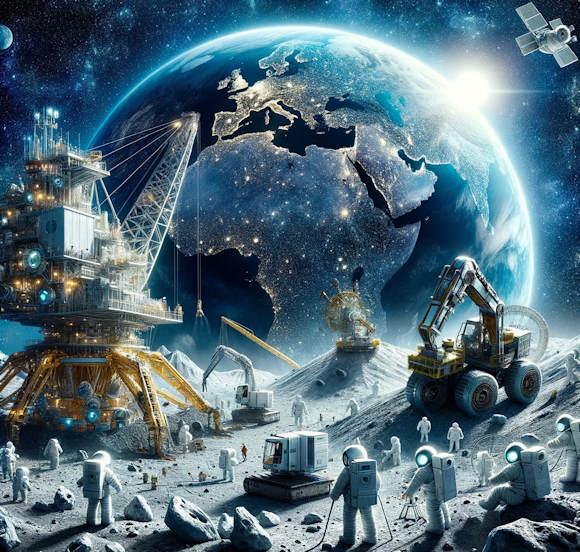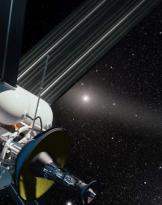Space exploration has roots almost as deep as humanity itself. Man has in fact always had a curiosity for the sky and astronomical events, trying over time to give his interpretation and to use the sky as an instrument.
A turning point in the study of the cosmos and its exploration occurred in 1957 with the launch of the first satellite Soviet Union in space, Sputnik, which paved the way forhuman and robotic space exploration.
The great step forward that this event constituted is largely due to the historical context, the Cold War, in which there was strong competition between the United States of America and the USSR. In this regard, space exploration was fueled by the struggle between the two superpowers, so much so that in this particular period it was called space race.
During this first turbulent phase the primates in the space race were divided between the USA and the USSR, where theUSSR claimed the launch of the first man in space, Yuri Gagarin, in 1961 and the first lunar fly-by with the Luna satellite in 1953 while the USA they allowed man to pose for the first time foot on the lunar soil with Neil Armstrong in 1969. This last and significant event calms the conflict on the space side and subsequently, towards the end of the Cold War, a period of stasis and reduction of funds allocated to space exploration begins in which the focus was more on exploration of the entire Solar System for scientific purposes and in which the first international collaborations began.
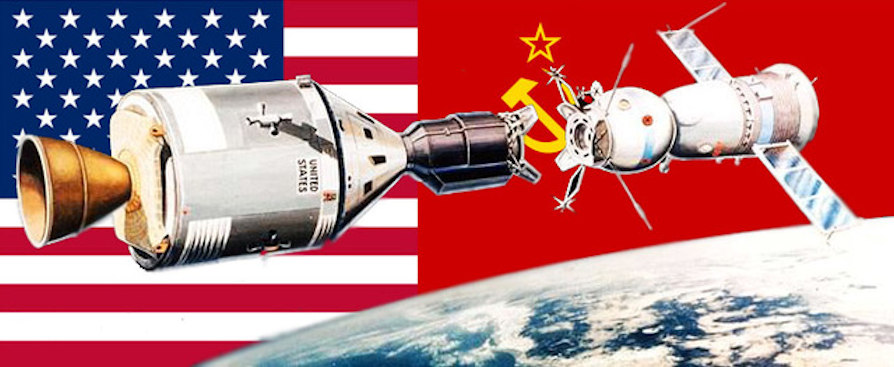
Figure 1: Comparative representation of the Apollo Command and Service Module (NASA) and the Soyuz spacecraft (ROSCOSMOS).
Today, space is becoming a protagonist and crucial element for the economy and development of the entire planet with the presence of satellites intended for the most diverse uses, such as Earth observation, communication and science, and contexts, such as military, civil or commercial.
The Solar System and its components
It is therefore certainly useful to briefly understand how our Solar System is structured in order to better understand what the opportunities are and the next steps to follow.
In this article we will therefore delve deeper into the scientific characteristics of some objects of interest in our Solar System and some of the technologies used for their study.
The Solar System is quite ancient, it was formed about 4.5 billion years ago from a cloud of extremely cold gas that collapsed on itself. It is located on the plane of the Milky Way, the spiral galaxy that hosts it, 8 kpc (about 200 million billion kilometers) from its center.
The Solar System is a complex object, made up of 8 Planets and several smaller objects, such as moons and asteroids, held together by the gravity of the Sun. The Sun is in fact the sticky of our system, is located roughly at the center of it and acts as the center of revolution for all the objects that orbit around us. The orbits of the planets are in fact elliptical in shape and this is important to understand how to best organize the movements of vehicles between one object and another within the System.
The Planets that make up the Solar System are divided into Terrestrial Planets, Mercury, Venus, Earth and Mars, e Jovian Planets, Jupiter, Saturn, Uranus and Neptune.
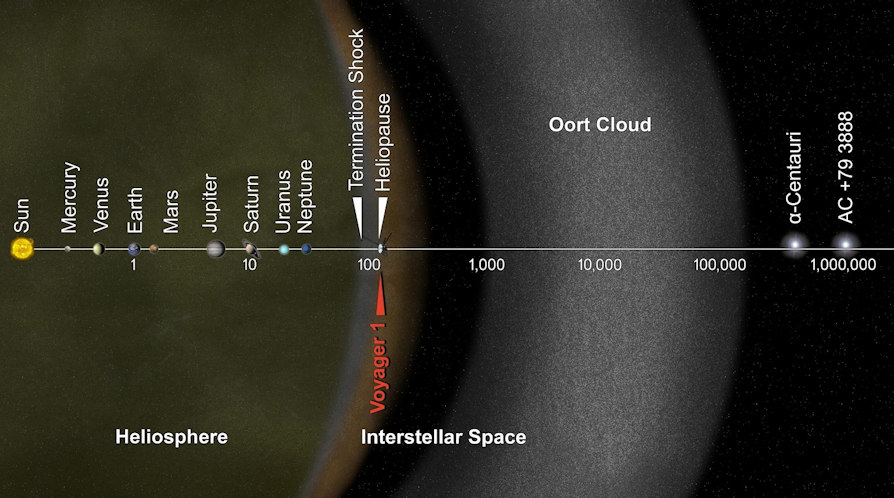
Figure 2: Schematic representation of the Solar System with its objects and their distances.
The Moon
The most easily explorable object and protagonist of the space race is the Earth's natural satellite, the Moon.
The Earth-Moon distance is equal to 356400 km at the perigee (closest point to the Earth) and 406700 km at the apogee (farthest point from the Earth). It has a revolution motion around the Earth in which a single revolution is called a sidereal month and lasts about 27 days while the rotation motion, on itself, is equal to the duration of the sidereal month, therefore making the motion of the Moon around the Earth a synchronous rotation. The peculiarity of this type of rotation is that in this way our Satellite always turns the same face towards the Earth.
Life on Earth has always been influenced by the presence of the Moon, both to account for the passage of time through the moon phases that during navigation with the presence of tide.
The Moon currently does not have a magnetic field like the Earth and has avery rarefied atmosphere, its surface is in fact dotted with craters caused by the impact with asteroids which, thanks to these properties of our Satellite, remain millions of years later. The lunar surface is usually divided into seas, characterized by now cooled lava flows, and plateaus. Furthermore, the soil is made up of lunar regolith, a layer of dust-like debris, and from breach, or rocky material that forms during meteorite impacts.
The lunar regolith is what allows us to study the composition of the lunar surface and not only because thanks to the absence of atmosphere and magnetic field, it is also possible to study solar activity based on the atoms deposited by the solar wind and the presence of cosmic rays. The lunar soil consists of the so-called KREEP, i.e. potassium (K), rare earths (in English rare earth elements REE) and phosphorus (P) while as regards the most common elements we have Calcium and Aluminum in the plateaus while in the seas which are predominantly basaltic we have Iron and Titanium.
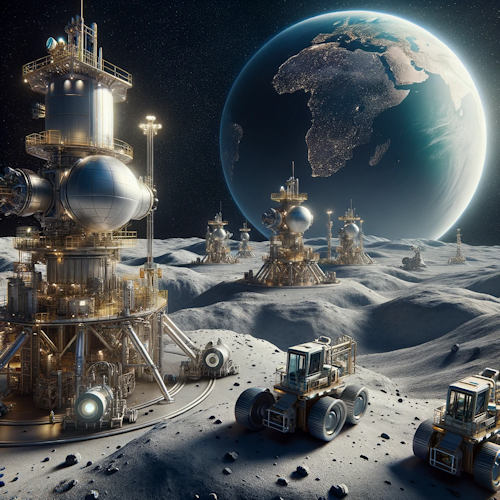 One of the most interesting materials that we can find on the lunar surface isHelium-3 (3He), an isotope of particular importance as it can be used in the reactions of nuclear fusion and in particular how fuel for space travel. The advantage that the use of this particular isotope of helium would bring lies in the production of a single neutron that can be easily intercepted during the fusion process and would therefore help to solve one of the main problems concerning nuclear fusion, namely the production of energetic neutrons from part of the reagents involved which causes the enrichment of the surrounding materials and their subsequent radioactive decay.
One of the most interesting materials that we can find on the lunar surface isHelium-3 (3He), an isotope of particular importance as it can be used in the reactions of nuclear fusion and in particular how fuel for space travel. The advantage that the use of this particular isotope of helium would bring lies in the production of a single neutron that can be easily intercepted during the fusion process and would therefore help to solve one of the main problems concerning nuclear fusion, namely the production of energetic neutrons from part of the reagents involved which causes the enrichment of the surrounding materials and their subsequent radioactive decay.
The reason why the merger a 3He has not yet been implemented on Earth is the scarcity of this isotope on our Planet. In fact, it is mainly transported by solar winds and cannot be deposited on Earth due to the presence of the magnetosphere which shields the Earth's surface from most of the radiation coming from the sun. The total amount of 3He on the lunar surface is estimated to be equal to 6.50 × 10^8 kg, about four orders of magnitude greater than the amount found on Earth.
The Moon, as described, was the first extraterrestrial body to be explored by man due to its relatively easy accessibility compared to other objects in the Solar System. The exploration of the satellite is currently far from over and several missions are underway or in preparation. The Indian mission Chandraayan 3 was recently successful with the landing of the Lander on August 23, 2023 in the area of the South Lunar Pole. This success made India the fourth country to reach lunar soil, after the historic achievements of the USSR and USA and the landing of the Chinese lander Chang'e 3 in 2013.
As regards future projects, particular importance is given to: Artemis chords, signed by several countries and led by the USA, which plan to return astronauts to lunar soil and build orbiting lunar stations.
Mars
Mars represents another important target for the exploration of the Solar System.
It is the fourth Planet of the Solar System and therefore the rocky Planet furthest from the Sun. Furthermore, it is one of the bodies in the Solar System that is best known and the target of scientific missions and human and robotic exploration.
The dimensions of Mars are smaller than the Earth, the radius of the Planet is in fact about 53% smaller than that of the Earth and its mass is about 11% and has two relatively small satellites called Phobos and Deimos. The Martian surface is covered almost completely with fine red powder, due to the presence of iron oxide and ferric hydroxide (Fe(OH3)), it gives the Planet the characteristic red color seen in visible light observations and reaches dimensions of less than 5 μm.
THEatmosphere It is made up of 95% CO2, together with 2% nitrogen and 0.1-0.4% oxygen and is significantly more rarefied than Earth's due to the difference in the size of the two Planets which does not allow Mars to have sufficient gravity to retain the lighter particles. Depending on the season the surface may be swept by winds which reach speeds of up to 100 m/s during the winter while during the summer the averages are around 10 m/s.
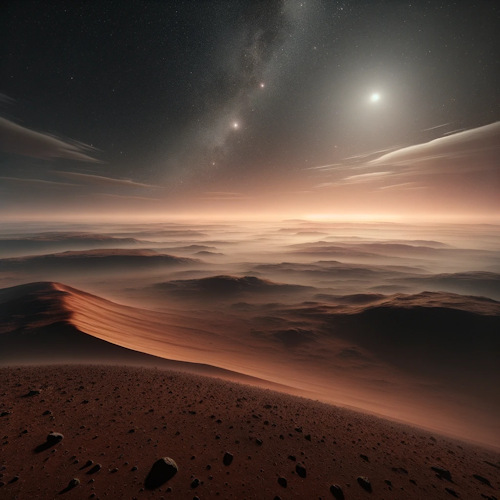
La temperature at surface level it is also variable depending on the season but generally it goes from 140 K to 240 K.
Some fine droplets of water are also dispersed in the atmosphere but in very small quantities compared to the abundances of the other elements. The presence of this small quantity of water in the atmosphere is regulated by the melting and hardening of the planet's polar caps during the seasons. In fact, the caps trap almost all of thewater present on Mars and it is estimated that the ice present there has a thickness of about 20 m. The presence of water was also inferred following the first observations from Earth due to the conformation of the surface, as there are erosive phenomena attributable to the presence of water in ancient times. Currently, the water present on the ground has evaporated and it is believed that it is possible that a layer of ice exists underground that has not yet undergone the evaporation phenomenon. However, the phenomenon of water evaporation on Mars remains a phenomenon unsolved mystery.
The planet Mars is one of the best-known objects of the Solar System as several missions have concentrated on studying the Planet, both at ground level, through rovers, and through orbiting probes. Of particular historical relevance is the NASA program Mariner, which in 1965 and 1968 allowed, respectively, the first fly-by to the planet and the installation of the first orbiting satellite, with the Mariner 9 mission.
Various exploration missions of the Planet are currently active, starting from the program NASA Mars 2020 which in 2020 brought the Perseverance rover and the Ingenuity drone to the program ExoMars led by ESA present with orbiters and landers up to the Chinese and Emirates programs which brought an orbiter and a rover for the Chinese mission tianwen-1 and an orbiter, called Hope, part of the Emirates mission Emirates Mars Mission.
The minor objects of the Solar System
The Solar System is made up of a variety of objects smaller than the Planets and having different sizes and compositions. We can therefore distinguish some areas of interest based on their position with respect to the Solar System.
Starting from the margins of the latter we have the Oort cloud, which is usually made to coincide with the ultimate limit of the System. It is composed of a large quantity of small ice-covered objects which, if disturbed, can be observed from Earth as Long Period Comets. Following calculations on the gravitational influence that the components of the Oort Cloud have on the other bodies of the System, it appears to have the shape of a spherical shell with an internal radius equal to 1-2 ⋅ 104 au and outer radius of about 1.5-2 ⋅ 105 au, or of the order of ten thousand times the Earth-Sun distance. From more recent studies on the origin of the Cloud it has been concluded that the number of objects that compose it should be around 1011, having an (estimated) mass of approximately [1-60] M⊕ (land masses).
More internally you have the Kuiper belt, an area that is also, like the Oort Cloud, populated by small icy objects. Its shape is donut-shaped and the objects that belong to it can be grouped according to their motion in a population in resonance: classical, diffuse and independent. The dimensions of the Kuiper belt are 31 au internally and 48 au externally. Some of the most famous Kuiper Belt objects are the Dwarf Planet Pluto and the object 486958 Arrokoth, also visited by the probe NASA New Horizons between 2015 and 2019.
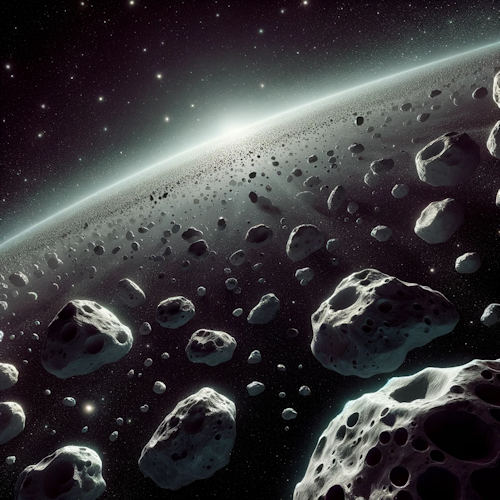 The asteroid belt within the Solar System is located between the terrestrial and Jovian planets. Yes you have one Main band which extends between about 2 au and 3.5 au and some other families called Hungaria, Cybele, Hilda and Troiani.
The asteroid belt within the Solar System is located between the terrestrial and Jovian planets. Yes you have one Main band which extends between about 2 au and 3.5 au and some other families called Hungaria, Cybele, Hilda and Troiani.
As regards the spectral classification of asteroids, it is usually based on the one introduced by Tholen in 1984, then subsequently expanded: C, P, D, B, S, V, A, R, K, L, E, M. However, the main and most common are classes C, S and M.
La composition of the asteroids in the Main Belt is varied, this phenomenon is presumably due to the dynamic mixing mechanism that occurred during the formation of the Solar System. C-type asteroids are quite ubiquitous, with a greater prevalence starting from the central zone of the Main Belt, while S-type asteroids prevail in the inner zone and among the Hungaria family.
Of particular importance for future space missions are the C- and M-type asteroids C-type asteroidsin fact, they can be found volatile materials like H2O, N2, O2, and CH4 which can be used in metallurgy, fuel production, agriculture and as a support for life in space. The M-type asteroids instead they can be a source of materials such as Germanium,Iridium,Antimony, and the remaining metals belonging to the Platinum group, as well as the Platinum same, Silver, Gold and other precious metals.
►Read the second part "The solar system, the resource of the future (2/4): the exploration of asteroids"
►Read the third part "The solar system, the resource of the future (3/4): lunar exploration"
►Read the fourth part "The solar system, the resource of the future (4/4): ethical-psychological considerations on human space exploration"
Sources
F. E. DeMeo and B. Carry. Solar System evolution from compositional mapping of the asteroid belt. , 505(7485):629–634, Jan 2014.
M. J. Duncan, R. Brasser, L. Dones, and H. F. Levison. The Role of the Galaxy in the Dynamical Evolution of Transneptunian Objects. In M.A. Barucci, H. Boehnhardt, DP
Cruikshank, A. Morbidelli, and R. Dotson, editors, The Solar System Beyond Neptune, page 315. 2008.
BL Ehlmann and CS Edwards. Mineralogy of the martian surface. Annual Review of Earth and Planetary Sciences, 42:291–315, 2014.
W. Fa and Y.-Q. Jin. Quantitative estimation of helium-3 spatial distribution in the lunar regolith layer. Icarus, 190(1):15–23, 2007.
H. Karttunen, P. Kröger, H. Oja, M. Poutanen, and KJ Donner. Fundamental astronomy. Springer, 2007.
D. S. McKay, G. Heiken, A. Basu, G. Blanford, S. Simon, R. Reedy, B. M. French, and J. Papike. The lunar regolith. Lunar sourcebook, 567:285–356, 1991.
T. Montmerle, J.-C. Augereau, M. Chaussidon, M. Gounelle, B. Marty, and A. Morbidelli. 3. solar system formation and early evolution: the first 100 million years. Earth, Moon, and Planets, 98:39–95, 2006.
JH Oort. The structure of the cloud of comets surrounding the Solar System and a hypothesis concerning its origin. Bulletin of the Astronomical Institutes of the Netherlands, 11:91–110, Jan. 1950.
MD Smith. Spacecraft observations of the Martian atmosphere. Ann. Rev. Earth Planet. Sci., 36:191–219, 2008.
F.W. Taylor, H. Svedhem, and J.W. Head. Venus: the atmosphere, climate, surface, interior and near-space environment of an earth-like planet. Space Science Reviews, 214:1–36, 2018.
R. C. Weber, P.-Y. Lin, E. J. Garnero, Q. Williams, and P. Lognonné. Seismic detection of the lunar core. science, 331(6015):309–312, 2011.
JJ Wray. Contemporary liquid water on Mars? Annual Review of Earth and Planetary
Sciences, 49:141–171, 2021
Images: OpenAI / ROSCOSMOS / author

